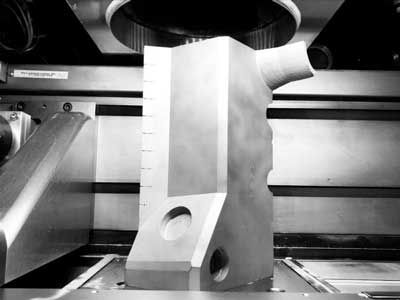| Dec 11, 2017 |
New research identifies how 3-D printed metals can be both strong and ductile
|
|
(Nanowerk News) A new technique by which to 3D print metals, involving a widely used stainless steel, has been show to achieve exception levels of both strength and ductility, when compared to counterparts from more conventional processes.
|
|
The findings, published in Materials Today ("Dislocation network in additive manufactured steel breaks strength–ductility trade-off"), outline how a joint research team from the University of Birmingham, UK, Stockholm University, Sweden and Zhejiang University, China were able to optimizing the process parameters during 3D printing to achieve the results.
|
|
The research is contrary to the sceptcism around the ability to make strong and ductile metals through 3D printing, and as such the discovery is crucial to moving the technology forward for the manufacturing of heavy duty parts.
|
 |
| 3-D printed part for nuclear fusion test reactor. (Image: Dr. Leifeng Liu, University of Birmingham)
|
|
3D printing has long been recognized as a technology which can potentially change our way of manufacturing, allowing us to rapidly build up objects with complex and customized geometries.
|
|
With the accelerating development of the technology in recent years, 3D printing, especially metal 3D printing, is quickly progressing toward widespread industrial application.
|
|
Indeed, the manufacturing giant General Electric (GE) has already been using metal 3D printing to produce some key parts, such as the fuel nozzles in their latest LEAP aircraft engine. The technology helps GE to reduce 900 separate components into just 16, and make fuel nozzles 40% lighter and 60% cheaper.
|
|
The global revenue from the industry is forecasted to be over 20 billion USD per year by 2025. Despite the bright future, the quality of the products from metal 3D printing has been prone to scepticism. In most metal 3D printing processes, products are directly built up from metal powders, which makes it susceptible to defects, thus causing deterioration of mechanical properties.
|
|
Dr. Leifeng Liu, who is the main participant of the project, recently moved to the University of Birmingham from Stockholm University as an AMCASH research fellow. He said, "Strength and ductility are natural enemies of one another, most methods developed to strengthen metals consequently reduce ductility."
|
|
"The 3D printing technique is known to produce objects with previously inaccessible shapes, and our work shows that it also provides the possibility to produce the next generation of structural alloys with significant improvements in both strength and ductility."
|
|
This has been made possible thanks to the ultrafast cooling rate, estimated to range from 1000oC per second to 100 million oC per second - something that was not possible in bulk metal production process until the emergence of 3D printing.
|
|
Metals that are cooled down so quickly result in a so-called non-equilibrium state, allowing for some amazing microstructures like the sub-micro-sized dislocation network - which was revealed in this paper to be the main reason of the improved mechanical properties.
|
|
Dr Liu continued, "This work gives researchers a brand new tool to design new alloy systems with ultra-mechanical properties. It also helps metal 3D printing to gain access into the field where high mechanical properties are required like structural parts in aerospace and automotive industry."
|
|
Dr. Yu-Lung Chiu, Dr. Ji Zou and Dr. Jing Wu, all from School of Metallurgy and Materials at the University of Birmingham, comprise the Birmingham team in this research. Dr. Chiu, who is in charge of the Electron Microscopy Centre, has established a micro and nano material testing system inside the electron microscopes which makes it possible to analyse in-situ the performance and mechanism of the sample during mechanical tests. It greatly helps to identify effective microstructural features for improved properties and, more importantly, to understand the mechanisms.
|

